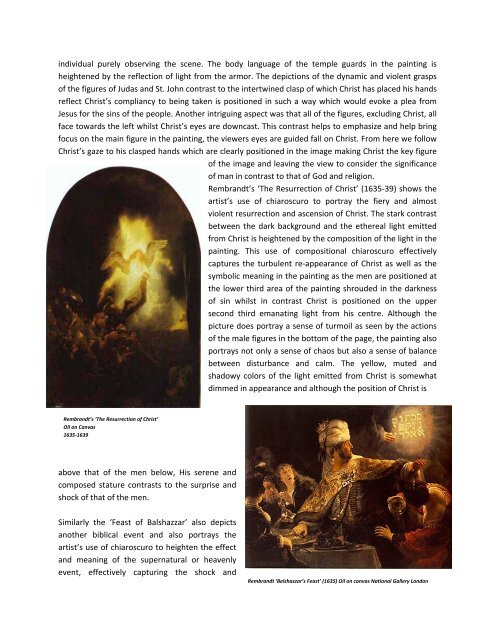A_Level_Personal_Studies_files/Chiaroscuro In Art.pdf
A_Level_Personal_Studies_files/Chiaroscuro In Art.pdf
A_Level_Personal_Studies_files/Chiaroscuro In Art.pdf
Create successful ePaper yourself
Turn your PDF publications into a flip-book with our unique Google optimized e-Paper software.
individual purely observing the scene. The body language of the temple guards in the painting is<br />
heightened by the reflection of light from the armor. The depictions of the dynamic and violent grasps<br />
of the figures of Judas and St. John contrast to the intertwined clasp of which Christ has placed his hands<br />
reflect Christ’s compliancy to being taken is positioned in such a way which would evoke a plea from<br />
Jesus for the sins of the people. Another intriguing aspect was that all of the figures, excluding Christ, all<br />
face towards the left whilst Christ’s eyes are downcast. This contrast helps to emphasize and help bring<br />
focus on the main figure in the painting, the viewers eyes are guided fall on Christ. From here we follow<br />
Christ’s gaze to his clasped hands which are clearly positioned in the image making Christ the key figure<br />
of the image and leaving the view to consider the significance<br />
of man in contrast to that of God and religion.<br />
Rembrandt’s ‘The Resurrection of Christ’ (1635-‐39) shows the<br />
artist’s use of chiaroscuro to portray the fiery and almost<br />
violent resurrection and ascension of Christ. The stark contrast<br />
between the dark background and the ethereal light emitted<br />
from Christ is heightened by the composition of the light in the<br />
painting. This use of compositional chiaroscuro effectively<br />
captures the turbulent re-‐appearance of Christ as well as the<br />
symbolic meaning in the painting as the men are positioned at<br />
the lower third area of the painting shrouded in the darkness<br />
of sin whilst in contrast Christ is positioned on the upper<br />
second third emanating light from his centre. Although the<br />
picture does portray a sense of turmoil as seen by the actions<br />
of the male figures in the bottom of the page, the painting also<br />
portrays not only a sense of chaos but also a sense of balance<br />
between disturbance and calm. The yellow, muted and<br />
shadowy colors of the light emitted from Christ is somewhat<br />
dimmed in appearance and although the position of Christ is<br />
Rembrandt’s ‘The Resurrection of Christ’<br />
Oil on Canvas<br />
1635-‐1639<br />
above that of the men below, His serene and<br />
composed stature contrasts to the surprise and<br />
shock of that of the men.<br />
Similarly the ‘Feast of Balshazzar’ also depicts<br />
another biblical event and also portrays the<br />
artist’s use of chiaroscuro to heighten the effect<br />
and meaning of the supernatural or heavenly<br />
event, effectively capturing the shock and<br />
Rembrandt ‘Belshazzar’s Feast’ (1635) Oil on canvas National Gallery London



